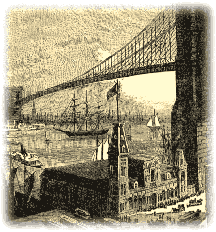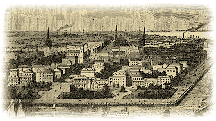US History 11th Grade Themes, Examples, Definition and Description - 1877-Present
What Do They Mean? Thats what the following paragraphs will explain.
Theme 1: Technological and economic growth defines and promotes American culture and economic expansion within the United States and the global community. (Civilization, Cultural Diffusion, and Innovation)
 A major theme in history is civilization, cultural diffusion and innovation; these concepts deal with the spread of tools, machines, traditions, lifestyles, laws, practices and ideas. To understand history we need to look at how groups of people have interacted, their goals, tools and inventions. Teachers of social studies must help students recognize the fluid interplay between different groups and the struggle to maintain a group identity while absorbing and accommodating change. Often once an idea has been unleashed it cannot be contained and frequently causes an unanticipated transformation---the process of diffusion.
A major theme in history is civilization, cultural diffusion and innovation; these concepts deal with the spread of tools, machines, traditions, lifestyles, laws, practices and ideas. To understand history we need to look at how groups of people have interacted, their goals, tools and inventions. Teachers of social studies must help students recognize the fluid interplay between different groups and the struggle to maintain a group identity while absorbing and accommodating change. Often once an idea has been unleashed it cannot be contained and frequently causes an unanticipated transformation---the process of diffusion.
Technological and economic growth continually influences the lifestyles of others, whether by intention or not. Examples include the technology necessary to complete the Transcontinental Railroad and the development of the tools which allowed the settlement of the Great Plains.
The spread and use of ideas and inventions among people causes them to change and evolve. The Internet allows for an unprecedented simultaneous worldwide exchange of ideas. Informal, instantaneous global conversation has implications far beyond what traditional institutions, such as government and schools, have been established to manage. So they too are changing, transformed by innovation.
Benchmark Alignment: I.1HS2, I.3HS1, I.2HS3, II.1HS1, II.3HS2, II.4HS4, III.2HS1, IV.5HS1
Theme 2: Development of natural resources and technological advances enabled the United States to rise to the level of a world power; yet choices about resource management and technological application remain controversial. (Human Interaction with the Environment)
Just as humans interact with each other, so do they interact with their environment. Events in history need to be seen in light of the struggles of humans to master nature by developing ways to use and control the environment. An understanding of global relationships among location, resources, climate, and other elements of the natural environment is necessary for making wise social and economic choices.
The Dust Bowl disaster of the 1930s is a result of this dynamic interaction. The Oklahoma migration of small farmers to the far west and the start of widespread national environmental awareness lead from this man-made disaster.
Also, the development of nuclear technology at the end of World War II established the United States as a world power.
Benchmark Alignment: I.4HS1, I.3HS3, I.4HS4, II.1HS1, II.2HS1, II.2HS2, II.4HS3, III.3HS1, IV.2HS2
Theme 3: Citizens needs, values and beliefs can shape governmental policies and institutions. (Values, Beliefs, Economics, Political Ideas and Institutions)
How people organize themselves into political, religious, social, and economic groups is important for students to have an understanding of history and modern life. An accurate understanding of why events occurred as they did is dependent on knowledge of the beliefs that were reflected in the institutions of the time. The relationships between the choices of how social structures allot the use of, and access to, resources leads to an understanding of how beliefs and values become institutions over time. Often ideas begin as commonly held assumptions that assume a pattern and become an institution: a social structure that supports the values and beliefs of the dominant culture as they evolve.
Labor unions provide a window into how human beliefs, political ideas, and distribution of resources develop into an institution. In the early 19th century, prevailing legal and social opinions and economic structures did not favor the development of unskilled workers organizations. Wages and the length of the workday were arranged directly in dealings between employers and individual workers. The disparity in power often led to abuse. The beliefs and values of trade unionists began to show in an organized way when they grouped together to form organizations. The Knights of Labor, the American Federation of Labor, the Industrial Workers of the World are some examples. Eight-hour workdays and health and safety protection for workers were important rallying points. Gradually the beliefs of organized labor became assumptions about the rights of workers and were embraced by society. As a result, legislation protecting the right to organize and the right of unions to enter into collective bargaining agreements with employers followed. Today, Americans accept the role of organized labor in many American businesses and governmental organizations. To achieve lasting learning, teachers of social studies need to help students identify the relationship between historical events and changing beliefs. Accepted beliefs often become assumptions that can evolve into institutions that support those beliefs.
Benchmark Alignment: I.1HS3, I.2HS1, I.2HS3, I.3HS3, I.4HS1, II.4HS4, III.1HS2, III.2HS2, III.4.HS1, IV.3HS4, IV.4HS1, IV.4HS4, VI.1HS1
Theme 4: Turmoil at home and conflict abroad causes America to take action and reevaluate its domestic and foreign policies. (Conflict and Cooperation)

American history can be meaningfully understood by viewing it in terms of cooperation and conflict. A complete look at American development must include ways people work together and cooperate during times of conflict as well as during times of peace. Furthermore, how we teach conflict and cooperation affects our students' responses to these events in their own lives. Conflicts in American history, both internal and external, include resolution of some while others remain unresolved.
Students can learn to identify recurring patterns through key events in United States history. Even in times of great conflict, there can also be cooperation. The social studies teacher brings the interplay between conflict and cooperation to light by providing students with examples of recurring patterns of human behavior. Much American history can be meaningfully understood by viewing it in terms of conflict and cooperation. A complete look at American development must include ways people work together and cooperate during times of conflict.
During World War II the cooperative efforts of women supported Americas industrial military needs. Social studies teachers insightfully forge a deeper understanding of this era of international conflict when they also characterize it as an era of national cooperation. Although the ordinary concerns and social and economic inequalities experienced by many Americans continued to exist during this era of national cooperation, citizens were dedication to winning the war. It is from the teacher of social studies that the student will gain insight into our nation in which the ordinary continues to exist side by side with the extraordinary. Students experience these same elements of conflict and cooperation in their own lives, and social studies educators give students a powerful tool for lasting understanding by teaching learners to recognize that these human patterns happen over and over, and so connect history to the present.
Benchmark Alignment: I.3HS3, I.2HS3, I.1HS3, II.4HS2, II.4HS3, II.5HS2, III.1HS2, III.5HS1, III.5HS2, IV.3HS4
Theme 5: Cultures change in reaction to major historical developments. (Comparative History of Major Developments)
Looking at differences and similarities help us clarify our understanding of people, times, and places. It can also help us gauge the importance of the topics being studied. Helping our students identify these relationships can provide an opportunity to make them more humane and avoid mistakes from the past. These comparisons can be pathways to insights into our times and ourselves.
Students can deepen their understanding of human development by looking at the emergence of a youth culture throughout 20th century America. By comparing the rebellious "flappers" of the 1920s, the "flower children" of Woodstock, and current generations, students will gain an understanding about each group and the times in which they emerged.
Cultural changes in the United States were often the result of movement of people. Three examples of major historical developments that caused cultural change include late 19th century immigration to the United States, migration of Dust Bowl farmers west and the migration of African Americans north.
Benchmark Alignment: II.1HS2, II.4HS4, III.3HS1, VI.1HS1, VI.2HS1
Theme 6: As society changes, ordinary Americans sometimes seek solutions to contemporary problems, yet others seek escape from social pressures. (Patterns of Social and Political Interaction)
The teaching of history includes an understanding of the role of all Americans, not just the famous. Social history accesses the daily experiences of the men and women who lived during the time being studied. These men and women have left the record of their lives in their labor, poetry, stories, dances, songs, letters, and a myriad of other informal sources. When teachers of social studies put learners into the social context of the time, students meet people from the past on their terms in their own times, and see them as important contributors to key events. This provides students with multiple points of view and gives them a vehicle to engage in critical questioning of historical sources such as: Whose voice am I hearing and why? What might a factory worker, a woman, an African American have thought about this issue?
We can teach students about social and political interactions from many points of view. Primary source documentation includes such items as personal journal entries, photographs, and folk songs. By using these social elements, as well as the more traditional secondary sources, we allow the learner to have a fuller picture of lives of people of the time. Students are better able to appreciate the hardships, efforts, and contributions of all men and women to the larger events in history.
The journalists of the Progressive Era gave a voice to the plight of working men, women, and children. The songs of organized labor provide a critical window into the lives of 20th Century Americans. The stories of significant members of the 1960s "counterculture" provide examples of Americans who, throughout our history, sought escape from social pressures.
Benchmark Alignment: I.2HS2, I.3HS1, I.3HS2, I.4HS4, II.1HS2, III.2HS2, III.4HS1, III.3HS2, IV.4HS3



